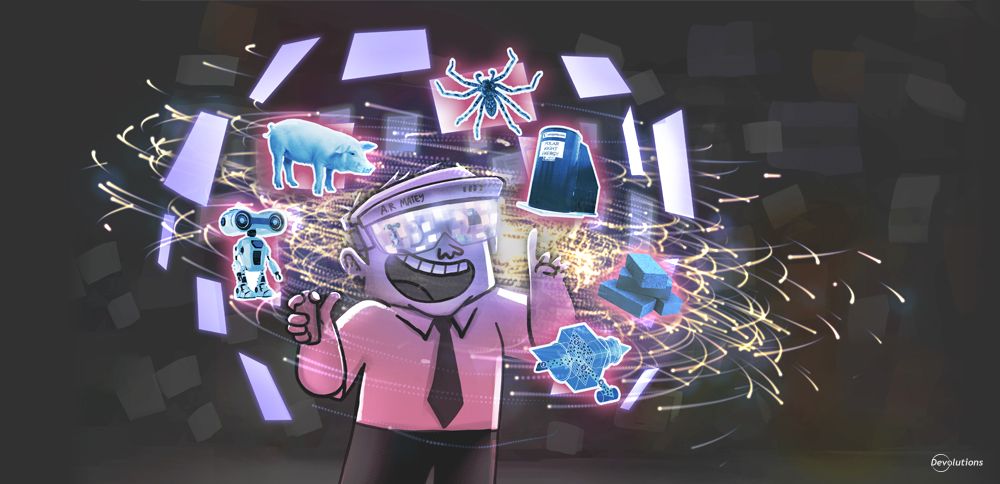The First Industrial Revolution used water and steam power to mechanize production. The Second Industrial Revolution used electric power to enable mass production. The Third Industrial Revolution used electronics and IT to automate production.
And now, according to futurists we are on the cusp of the Fourth Industrial Revolution, which will use increasing interconnectivity and smart automation to deliver rapid, unprecedented — and in many ways unexpected — change to technology, industries, and societal patterns and processes, and blur the lines between the physical, digital, and biological spheres.
Below, we highlight 10 tech trends that will change the world — in some ways that we anticipate, and possibly in more ways that we do not:
Necrobotics
Necrobotics is the practice of using biotic materials — or dead organisms — as robotic components. For example, mechanical engineers at Houston’s Rice University demonstrated last year how to transform deceased spiders into “mechanical grippers” that could lend into natural environments while picking up objects that outweigh them, such as insects.
Currently, the concept of necrobotics is still in its very early stages. However, there is astonishing potential (and perhaps a whole new genre of horror movie!).
Sand Batteries
A sand battery is a high temperature thermal energy storage, which uses sand (or sand-like materials that function as a super conductor) as its storage medium. It can store heat generated by low-cost solar or wind-generated electricity for months. The first sand battery was constructed by Finnish startup company, Polar Night Energy alongside Finland-based energy utility Vatajankoski. The project has delivered the first commercially viable sand-based energy storage solution anywhere in the world.
Right now, the biggest challenges for sand batteries are — as is often the case with breakthrough technology concepts — cost and scalability. However, there is hope that both of these obstacles will be overcome in the near future, which would unleash a whole new level of green tech. As noted by IEEE, which is the world’s largest professional association for the advancement of technology: “Affordable thermal storage could help industries and cities capture heat that is currently wasted, as well as balance the inconsistencies in wind and solar power output.”
Xenotransplantation
Xenotransplantation is the procedure of transplanting, implementing, or infusing a human being with organs, cells, or tissues from an animal source. The most famous xenotransplantation surgery occurred many years ago.
In 1984, a baby was born with a heart defect that would have killed her in a matter of days. Her surgeon Leonard Lee Bailey was a pioneer in animal-animal transplants, and decided to try transplanting a baboon heart; not as a permanent solution, but to enable the baby (who came to be known as “Baby Fae”) to live long enough for a second, human transplant in the near future. Tragically, Baby Fae died 21 days later after her body rejected the baboon heart. However, that event was the first serious attempt at xenotransplantation.
Now, four decades later, interest in xenotransplantation has been re-ignited — and so has the ethnical debate and controversy around it — as a way to address the global, severe organ shortage problem that costs millions of lives each year. As Columbia University’s Irving Medical Center points out: “Xenotransplantation is about much more than achieving a procedure that feels like it belongs in science fiction. It’s a priority to many transplantation surgeons and experts because it could address many of the barriers that have existed in organ access for decades.”
Brain-Reading Robots
For several years, technology has existed to assist tetraplegic individuals (those who cannot move their upper or lower body) interact with the world. However, this technology relied on individuals providing some kind of input.
Now, technology is emerging that leverages machine learning to estimate and understands brain signals, but without active inputs from an individual. For example, the algorithm could theoretically and potentially interpret a wheelchair-bound individual’s brain activity, in order to grasp that individual’s preferences regarding speed, distance from other objects, and other variables. It has also been posited that these so-called “brain reading robots” could one day recognize an individual’s contextual circumstances, and adjust accordingly in-the-moment. For example, a wheelchair would automatically know to shift risk tolerance if an individual was late for an appointment.
In a way, what this remarkable technology aims to do is capture an individual’s mood and feelings, and use that information to enhance their day-to-day experience. But for now, the biggest obstacle is ensuring consistency over time from the algorithm. Commented the BBC: “Without that consistency, the algorithm could be thrown off in real life situations. If, for example, someone was driving a wheelchair in a crowd and passed people in an argument, the person could generate an error which has nothing to do with the driving experience.”
Direct Air Capture
Trees play an essential role in reducing carbon dioxide (CO2) in the atmosphere through the process of photosynthesis. However, this requires a great deal of land — which is in ever-shrinking supply. That is where direct air capture (DAC) technology could change the paradigm.
DAC involves pulling CO2 from the air, and storing it in geological caves deep underground, or combining it with hydrogen to create synthetic fuels. There are currently 18 DAC plants operating worldwide, which are collectively capturing almost 0.01 Mt of CO2 each year. By 2030, DAC is expected to capture almost 60 Mt of CO2 each year.
While DAC has incredible potential, there are some significant issues and challenges to overcome — most notably that DAC plants need a massive amount of energy to run. However, if this burden can be scaled back, then DAC could be a transformative breath of fresh air for generations to come.
Energy-Storing Bricks
We know about smartphones, smart TVs, and smart homes. Well, in the coming years we will hopefully add another member to the smart landscape: smart bricks!
Researchers at Washington University in St Louis have developed a method of applying a conducting coating — known as PEDOT — onto brick samples, which then seeped through the fired bricks’ porous structure and converted them into energy storing electrodes; essentially turning the bricks into a battery.
The great news is that these smart bricks only cost about $3 USD each to make. The not-so-great news is that, at the current time, energy storage capacity is extremely low — about 1% of a lithium ion battery (enough to illuminate a LED light bulb). However, there is a great deal of promise and excitement. The researchers hope that by mixing certain transition metals into the bricks, such as manganese, they can significantly increase the energy storage capacity.
Living Concrete
Researchers at the University of Colorado Boulder have developed what is being dubbed as “living concrete” made of sand, gel and bacteria. This could pave the way (yes, pun intended!) for future building structures that could heal their own cracks, detect and respond to toxic chemicals, or even that light up to reveal structural damage.
The minerals in the new material are deposited by cyanobacteria, which is a common class of microbes that capture energy through photosynthesis. The process absorbs CO2, compared to the production of regular concrete which emits massive amounts of greenhouse gas.
Right now, researchers are focused on making living concrete stronger, as well as increasing resistance to dehydration. They are also looking at ways to reconfigure the material so that it can be more easily assembled and flat-packed — which could open up the possibility of applying this technology on other planets, such as Mars. Commented Wil Srubar, a structural engineer at the University of Colorado Boulder, and head of the research project “There’s no way we’re going to carry building materials to space. We’ll bring biology with us.”
Perspiration-Powered Smartwatches
Engineers at the University of Glasgow have developed a new type of flexible supercapacitor that stores energy, and subsequently swaps electrolytes found in conventional batteries with perspiration.
Here’s how it works: a polyester cloth absorbs positive and negative ions in sweat. These ions interact with the polymer’s surface, which creates an electrochemical reaction — therefore generating energy. The supercapacitor can be completely charged with as little as 20 microlitres of sweat (about 4 drops), and is robust enough to endure 4,000 cycles.
Still, there are some problems to solve before perspiration-powered smartwatches enter the mainstream and experience mass adoption. Chiefly, researchers need to figure out how to make the battery last even when wearers aren’t sweating. One idea is to add a back-up conventional battery. While this isn’t an ideal solution, it could be a bridge to a better, 100% battery-free smartwatch in the (hopefully not-too-distant) future.
AI Image Generation
We are all familiar with conventional image search, which is when we put a term like “puppy” into a search engine, click images, and get thousands upon thousands of image possibilities — everything from stock photos to clipart.
However, there is an emerging tech known as AI image generation, which is going far beyond just harvesting existing images — it is actually creating brand new, original images based on simple worded prompts.
This technology from OpenAI, known as Dall-E, is in its second iteration (“Dall-E 2”). There have been some impressive improvements from the original iteration, including better image resolution, faster image-creation time, and a more intelligent algorithm.
However, there are still some issues to overcome before Dall-E 2 (or a subsequent iteration) is as wonderful and amazing as the character it was named after, Wall-E. For example, if you ask for an image of a “back hole inside of a box,” Dall-E 2 will take the request literally and deliver an image with a black circle (representing a hole) inside of a box. But what if you actually wanted an image of a cosmic black hole? In addition, Dall-E 2 can run into trouble with variable blending. For example, if you ask it to draw a red cube on top of a blue cube, you sometimes get a blue cube on top of a red cube.
And on top of this, there a growing, swirling ethical debate about how this technology could be (and in fact, already is) being used for nefarious purposes such as propaganda and “fake news.”
Right now, Dall-E 2 is being slowly rolled out (there is a waitlist), and there are no official plans to release it to the general public. Commented Aditya Ramesh, one of the project’s lead researchers: “We want to put this research into the hands of people but for the time being, we’re just interested in getting feedback on how people use the platform. We are definitely interested in deploying this technology more widely, but we currently have no plans for commercialisation.”
Catapulting Satellites into Space
The conventional way to get satellites in space is by hitching them onto rockets. However, there is the possibility that in the years to come satellites essentially get catapulted to their destination. Yes, we’re serious!
There is now a prototype system for getting satellites (or any other payloads) into space by using kinetic energy. Essentially, the satellite would be hitched to a launcher and spun at a staggering 8,000km/h and 10,000G, before it is launched upwards through a giant tube.
Right now, the concept doesn’t completely eliminate rocket engines, which would still be necessary to get satellites into orbit. However, the company behind the tech, SpinLaunch, says that this could reduce fuel and infrastructure by 70%.
Looking Ahead
These are just some of the many technical ideas that will usher in the Fourth Industrial Revolution, and one day in the distant future will be reflected on as conventional rather than astonishing. While we don’t know what is going to unfold, we can say with certainty that it will be very, very interesting.
What’s Your Take?
Share your thoughts on these (and other) tech ideas. Post your comments below. Are you excited about what’s on the horizon? Apprehensive? Perhaps a mix of both? Let the community know what you think, expect, and advise.





